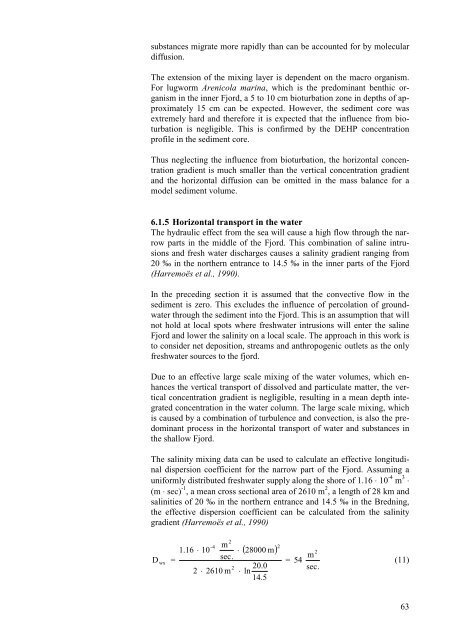Phthalates and Nonylphenols in Roskilde Fjord
Phthalates and Nonylphenols in Roskilde Fjord
Phthalates and Nonylphenols in Roskilde Fjord
Create successful ePaper yourself
Turn your PDF publications into a flip-book with our unique Google optimized e-Paper software.
substances migrate more rapidly than can be accounted for by moleculardiffusion.The extension of the mix<strong>in</strong>g layer is dependent on the macro organism.For lugworm Arenicola mar<strong>in</strong>a, which is the predom<strong>in</strong>ant benthic organism<strong>in</strong> the <strong>in</strong>ner <strong>Fjord</strong>, a 5 to 10 cm bioturbation zone <strong>in</strong> depths of approximately15 cm can be expected. However, the sediment core wasextremely hard <strong>and</strong> therefore it is expected that the <strong>in</strong>fluence from bioturbationis negligible. This is confirmed by the DEHP concentrationprofile <strong>in</strong> the sediment core.Thus neglect<strong>in</strong>g the <strong>in</strong>fluence from bioturbation, the horizontal concentrationgradient is much smaller than the vertical concentration gradient<strong>and</strong> the horizontal diffusion can be omitted <strong>in</strong> the mass balance for amodel sediment volume.6.1.5 Horizontal transport <strong>in</strong> the waterThe hydraulic effect from the sea will cause a high flow through the narrowparts <strong>in</strong> the middle of the <strong>Fjord</strong>. This comb<strong>in</strong>ation of sal<strong>in</strong>e <strong>in</strong>trusions<strong>and</strong> fresh water discharges causes a sal<strong>in</strong>ity gradient rang<strong>in</strong>g from20 ‰ <strong>in</strong> the northern entrance to 14.5 ‰ <strong>in</strong> the <strong>in</strong>ner parts of the <strong>Fjord</strong>(Harremoës et al., 1990).In the preced<strong>in</strong>g section it is assumed that the convective flow <strong>in</strong> thesediment is zero. This excludes the <strong>in</strong>fluence of percolation of groundwaterthrough the sediment <strong>in</strong>to the <strong>Fjord</strong>. This is an assumption that willnot hold at local spots where freshwater <strong>in</strong>trusions will enter the sal<strong>in</strong>e<strong>Fjord</strong> <strong>and</strong> lower the sal<strong>in</strong>ity on a local scale. The approach <strong>in</strong> this work isto consider net deposition, streams <strong>and</strong> anthropogenic outlets as the onlyfreshwater sources to the fjord.Due to an effective large scale mix<strong>in</strong>g of the water volumes, which enhancesthe vertical transport of dissolved <strong>and</strong> particulate matter, the verticalconcentration gradient is negligible, result<strong>in</strong>g <strong>in</strong> a mean depth <strong>in</strong>tegratedconcentration <strong>in</strong> the water column. The large scale mix<strong>in</strong>g, whichis caused by a comb<strong>in</strong>ation of turbulence <strong>and</strong> convection, is also the predom<strong>in</strong>antprocess <strong>in</strong> the horizontal transport of water <strong>and</strong> substances <strong>in</strong>the shallow <strong>Fjord</strong>.The sal<strong>in</strong>ity mix<strong>in</strong>g data can be used to calculate an effective longitud<strong>in</strong>aldispersion coefficient for the narrow part of the <strong>Fjord</strong>. Assum<strong>in</strong>g auniformly distributed freshwater supply along the shore of 1.16 ⋅ 10 -4 m 3 ⋅(m ⋅ sec) -1 , a mean cross sectional area of 2610 m 2 , a length of 28 km <strong>and</strong>sal<strong>in</strong>ities of 20 ‰ <strong>in</strong> the northern entrance <strong>and</strong> 14.5 ‰ <strong>in</strong> the Bredn<strong>in</strong>g,the effective dispersion coefficient can be calculated from the sal<strong>in</strong>itygradient (Harremoës et al., 1990)Dwx=-4 m1.16 ⋅ 10 ⋅sec.22 ⋅ 2610 m ⋅2( 28000 m)20.0ln14.52=542msec.(11)63
















